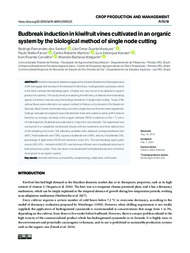Budbreak induction in kiwifruit vines cultivated in an organic system by the biological method of single node cutting.
Budbreak induction in kiwifruit vines cultivated in an organic system by the biological method of single node cutting.
Author(s): SANTOS, R. F. dos; MARQUES, L. O. D.; MELLO-FARIAS, P.; MARTINS, C. R.; KONZEN, L. H.; CARVALHO, I. R.; MALGARIM, M. B.
Summary: Kiwifruit vines are an alternative approach to diversify Brazilian fruit farming because of the low supply and increase in the demand for their fruits. Hydrogenated cyanamide, which is the most common rest-breaking agent, is highly toxic and its use is not allowed in organic production systems. This study aimed at evaluating the efficiency of alternative rest-breaking agents in kiwifruit vines by using the biological method of single node cutting. Twigs of the cultivar Bruno were collected in an organic orchard in Pelotas, a city located in Rio Grande do Sul state, Brazil. Seven-centimeter-long cuts with a single shoot at the ends were segmented. Cuttings were placed on plastic trays with phenolic foam and soaked in water, at 85% relative humidity on average, and kept in bio-oxygen demand (BOD) incubators at 25± 1 °C and a 16-h photoperiod. Budbreak was evaluated in 2-day and 3-day intervals. The experiment was conducted in a completely randomized design with ten treatments and three replications of ten sampling units each. The following variables were analyzed: average budbreak time (ABT), final budbreak rate (FBR), vigorous budbreak rate (VBR), velocity of budbreak (VB), percentage of open buds (POB) and dormancy index (DI). The rest-breaking agent garlic extract (GE) 10% + mineral oil (MO) 2% was the most efficient one in budbreak induction in both production cycles. Thus, this dose is recommended for budbreak induction in kiwifruit vines grown in an organic system.
Publication year: 2020
Types of publication: Journal article
Keywords: Brotacao, Cultivar Bruno, Kiwi
Observation
Some of Embrapa's publications are published as ePub files. To read them, use or download one of the following free software options to your computer or mobile device. Android: Google Play Books; IOS: iBooks; Windows and Linux: Calibre.
Access other publications
Access the Agricultural Research Database (BDPA) to consult Embrapa's full library collection and records.
Visit Embrapa Bookstore to purchase books and other publications sold by Embrapa.

